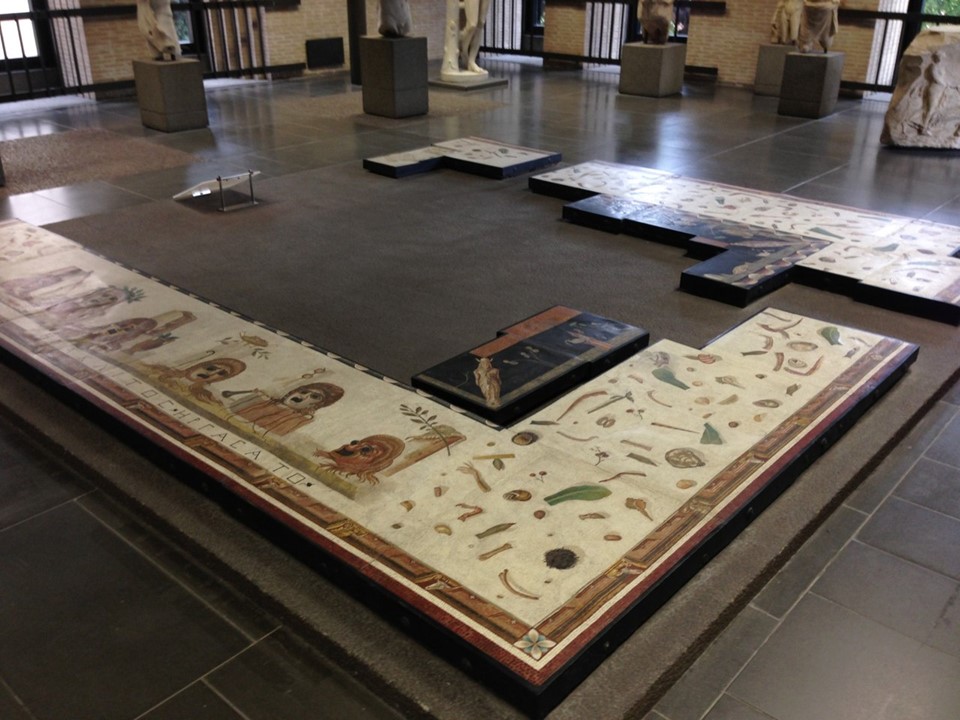
Heraklitos and the Asarotos Oikos Mosaic is one of the many reasons why you should visit the Gregoriano Profano Museum in the Vatican! It’s an exhibit I dearly love, a mosaic that amuses me, tests my observation… a work of art of the highest quality!
The story of the Asarotos Oikos theme in mosaic-work takes us back to the Hellenistic Period, to the great city of Pergamon on the coast of Asia Minor, and to a legendary mosaicist, called Sosus (εκ Περγάμου ψηφιδογράφος Σώσος). Pliny the Elder describes Hellenistic mosaic making and Sosus’s accomplishments as “…Paved floors originated among the Greeks and were skilfully embellished with a kind of paintwork until this was superseded by mosaics. In this latter field the most famous exponent was Sosus, who at Pergamum laid the floor of what is known in Greek as ‘the Unswept Room’ because, by means of small cubes tinted in various shades, he represented on the floor refuse from the dinner table and other sweepings, malting them appear as if they had been left there…” Pliny, Natural History, 36.60.25 https://www.loebclassics.com/view/pliny_elder-natural_history/1938/pb_LCL419.145.xml?readMode=reader
The Gregoriano Profano Museum in the Vatican has one of the finest Asarotos Oikos mosaics, carefully executed and brightly colored. It was discovered in 1833, on the Aventine Hill in Rome, and as the archaeologists established, it decorated the dining room floor of a Hadrian period villa. This is a unique mosaic, the masterpiece of Heraklitos, the mosaicist, proud to sign his name.
Heraklitos created a complex floor mosaic composition. The threshold of the triclinium (the Roman dining-room) greeted guests with a design of theatrical masks, ritual objects, and the mosaicist’s signature! The central mosaic decoration presented a complex Nilotic scene, now mostly destroyed. The Assarotos Oikos themed mosaic, boarder-like, covered the four sides of the room depicting, on a white background, “…the debris of a banquet, the remains that would normally be swept away.” It is amusing for me to try to identify what Heraklitos depicted on this amazing floor… fruit, leafy vegetables, lobster and crab claws, clams and oysters, sea urchins, chicken bones, and nutshells, even a tiny mouse, gnawing on a walnut shell. I am equally amazed at the artist’s skill to demonstrate an understanding of three-dimentionality by using contrasting colors and casting shadows against the white floor background. http://www.museivaticani.va/content/museivaticani/en/collezioni/musei/museo-gregoriano-profano/Mosaico-dell-asarotos-oikos.html
An interesting article titled “The asàrotos òikos mosaic as an elite status symbol” by Ehud Fathy of the Tel Aviv University provides an interesting explanation of how we should read this mosaic theme. “The asàrotos òikos mosaics have all been discovered exclusively in the domestic spaces of the Roman elite. The manufacturing of such detailed mosaics must have demanded great financial investment, and while the mosaics must have amused the guests with their Trompe-l’œil qualities, it is hard to believe that such an expenditure was made with this sole purpose in mind. The aim of this article is to explore the asàrotos òikos mosaics as a Roman status symbol of elitist erudition… ” file:///C:/Users/aspil/Downloads/Dialnet-TheAsarotosOikosMosaicAsAnEliteStatusSymbol-6037238%20(1).pdf
For a PowerPoint on the Vatican Asarotos Oikos Mosaic, please… click HERE!